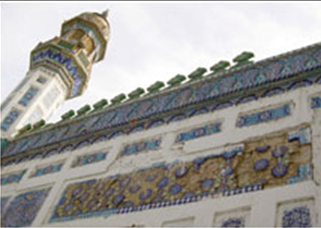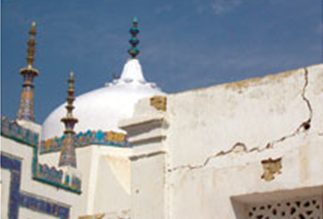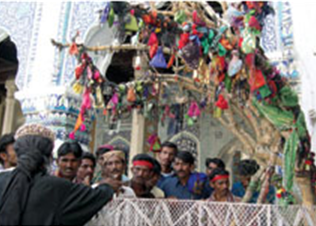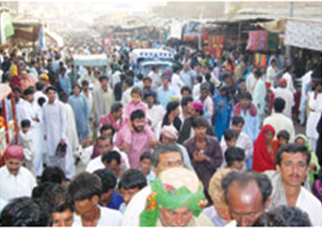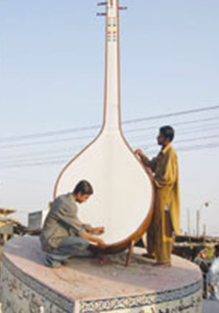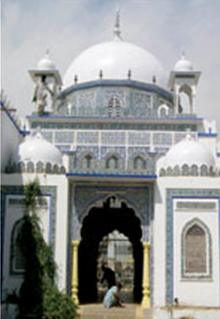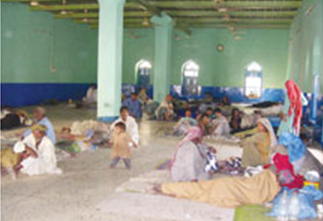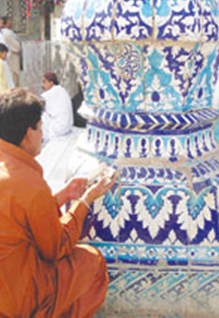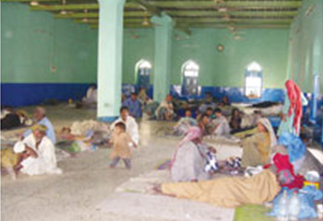Bhittai: Bopi Beelo, Khipro taluka
(→Bhittai: Bopi Beelo, Khipro taluka) |
(→Bhittai: Bopi Beelo, Khipro taluka) |
||
| Line 41: | Line 41: | ||
Sindh’s ruler, Ghulam Shah Kalhoro, a Bhittai devotee, built his tomb. Later on more construction was carried out with donations. In 1960, the Auqaf department took control of the dargah, prior to that his descendants looked after it. Shah Jamal Shah, the nephew of Bhittai, was the first sajjada-nasheen when the saint departed. | Sindh’s ruler, Ghulam Shah Kalhoro, a Bhittai devotee, built his tomb. Later on more construction was carried out with donations. In 1960, the Auqaf department took control of the dargah, prior to that his descendants looked after it. Shah Jamal Shah, the nephew of Bhittai, was the first sajjada-nasheen when the saint departed. | ||
[[File:Bhitta Bopi Beelo, Khipro taluka3.PNG| Bhitta Bopi Beelo, Khipro taluka.|frame|500px]] | [[File:Bhitta Bopi Beelo, Khipro taluka3.PNG| Bhitta Bopi Beelo, Khipro taluka.|frame|500px]] | ||
| − | + | ||
| − | + | ||
The dargah attracts close to 0.4 million devotees including foreigners during the three days of urs. They make generous donations, too. Such visits continue throughout the year. Regrettably, though, the donors have neither any say in holding of celebrations nor are they provided with any facilities during their stay at the dargah. The place lacks the supply of clean drinking water and its absence is greatly felt during the long months of summers. The guest houses –– with leaking roofs –– are in deplorable conditions. | The dargah attracts close to 0.4 million devotees including foreigners during the three days of urs. They make generous donations, too. Such visits continue throughout the year. Regrettably, though, the donors have neither any say in holding of celebrations nor are they provided with any facilities during their stay at the dargah. The place lacks the supply of clean drinking water and its absence is greatly felt during the long months of summers. The guest houses –– with leaking roofs –– are in deplorable conditions. | ||
Revision as of 09:42, 25 October 2013
This is a collection of articles archived for the excellence of their content. Readers will be able to edit existing articles and post new articles directly |
Bhittai: Bopi Beelo, Khipro taluka
The neglected dargah
Text and photographs by M.H. Khan
The 262nd Urs of the great mystic poet Shah Abdul Latif Bhittai began on March 15 and will continue till March 17. The proceedings begin soon after the morning prayers with Bhittai’s faqirs (his disciples) starting the celebrations by reciting Bhittai’s kalam, followed by a mehfil-e-sama. The sajjada-nasheen offers the ‘dua’ in the presence of devotees who turn up in large numbers.
On the third day, the sajjada- nasheen dresses up the way Shah Abdul Latif Bhittai did, along with a ‘godri’ on the shoulder for his followers. The proceedings end after he offers a collective prayer.
Sindh’s ruler, Ghulam Shah Kalhoro, a Bhittai devotee, built his tomb. Later on more construction was carried out with donations. In 1960, the Auqaf department took control of the dargah, prior to that his descendants looked after it. Shah Jamal Shah, the nephew of Bhittai, was the first sajjada-nasheen when the saint departed.
The dargah attracts close to 0.4 million devotees including foreigners during the three days of urs. They make generous donations, too. Such visits continue throughout the year. Regrettably, though, the donors have neither any say in holding of celebrations nor are they provided with any facilities during their stay at the dargah. The place lacks the supply of clean drinking water and its absence is greatly felt during the long months of summers. The guest houses –– with leaking roofs –– are in deplorable conditions.
The disciples are charged for using the lavatories. For two meals a day, the amount allocated by the Auqaf department for the lungar (free meal) is Rs500 per month, which is quite ridiculous. A large portion of the dhamal court does not have a plastered floor, despite the fact that people have offered to lay quality marble tiles in the premises.
On April 17, 2003, the then Sindh Chief Minister announced Rs25 million for the beautification and renovation of the mazar, and thanks to the efforts of the Auqaf ministry the funds were released on time. They were supposed to be spent on air-conditioning of the dargah and adjacent mosque, sound system, installation of lights, extension of courtyard, construction of a rest-house and purchase of generators. It was said that the project would be completed within two years. However, the reality is quite different. The promised work hasn’t even begun as yet, due to the bureaucratic delays.
In some portions, tiles of the dargah’s dome and adjacent mosque have become loose as the entire structure is made of mud/limestone. Cracks are also visible in the mosque and rear side of the dargah. The main route to the dargah is heavily encroached and the devotees have a hard time negotiating through the area.
Karar Lake has been mentioned in Shah jo Risalo. It is said that Bhittai used to take water from it for ablution and drinking. The devotees believe it cures the sick and the ailing. Regrettably, it has now become more a public urinal. Garbage is dumped on its banks thus polluting it further. A few years back, a decision had been taken that tube-wells would be installed for a permanent supply of water but no one knows what happened to that proposal.
The lake was partitioned after a road was constructed which led to the cultural centre. The bifurcated part is called ‘Karar Park’ which doesn’t fulfill the criterion of a park. It’s an empty space, being used as a taxi stand. A tourist motel –– a cheap lodging facility meant for the devotees –– has been converted into the office of SDO (operations) Hyderabad Electric Supply Company (HESCO).
In comparison to all these places, the guest-house of the culture department in the same vicinity, where government functionaries and ministers stay, is well furnished, clean and properly maintained. It depicts the trend of the VIP culture in society.
The culture department focuses only on the three days of urs, spending huge amounts on cultural and musical nights and adabi conferences. The culture as well as Auqaf departments and the local community of Bhitshah seem to have turned a blind eye to the uplift of the infrastructure.
The concerned departments need to be proactive as Bhittai is a legendary figure of the country. Like the dargah of Lal Shahbaz Qalandar, Bhittai’s dargah also needs renovation.
